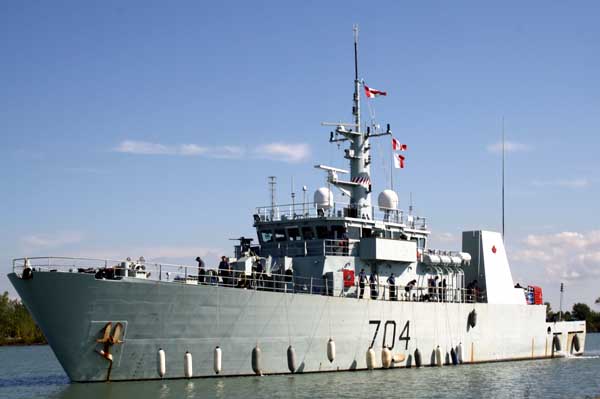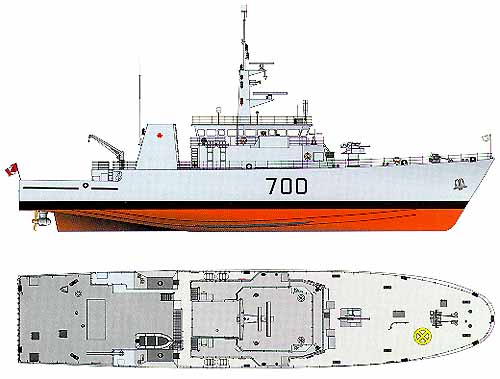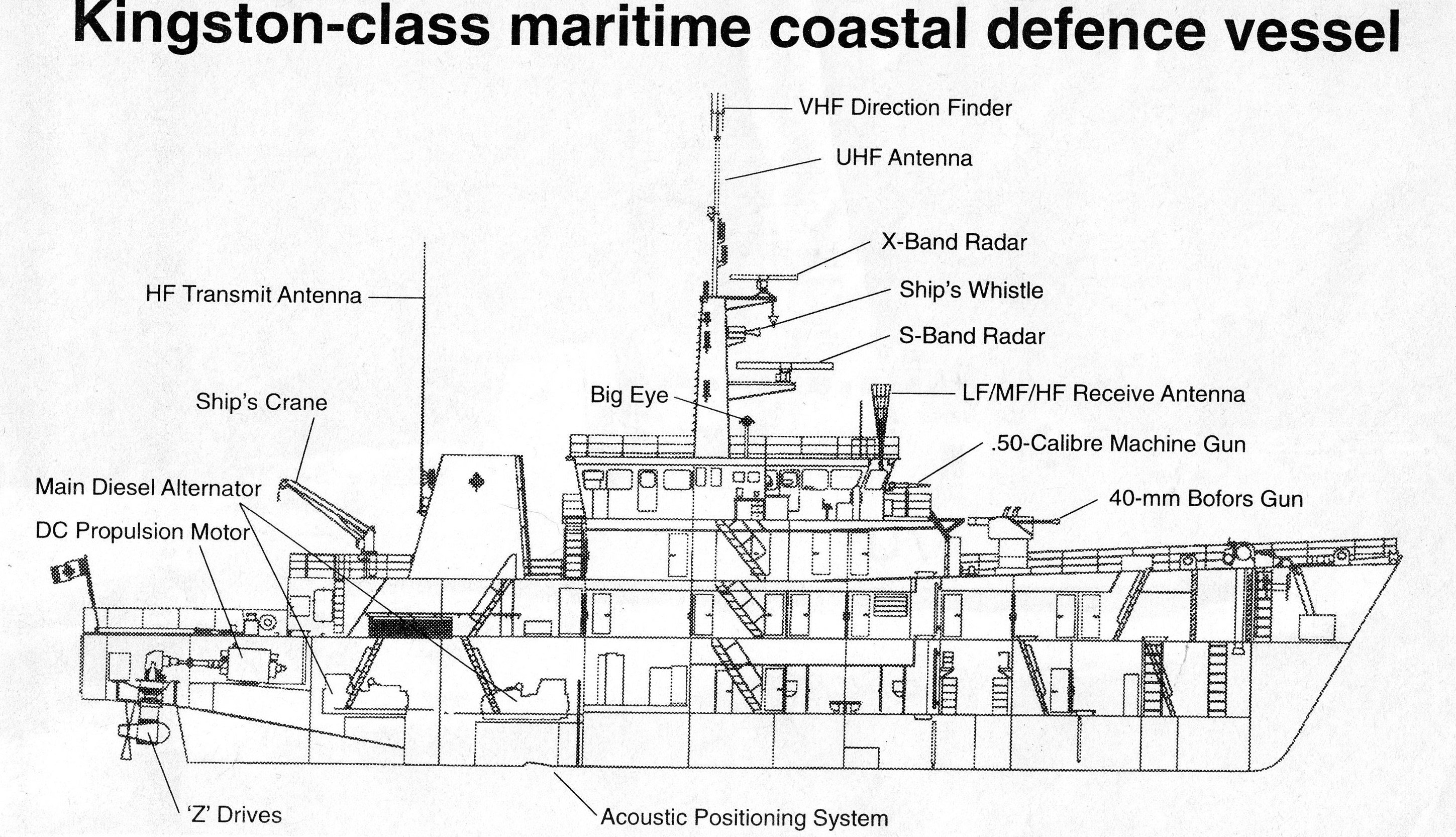 |
| HMCS Shawinigan is transiting the Welland Canal on Sept 20, 2011. She is downbound, just above Lock 1 in this photo. (Photo by Ian Baker VE3OZN) |
In the late 1980's, the Canadian Navy recognized the need for an effective coastal defence platform that would complement Canada's maritime forces. The decision to build 12 Maritime Coastal Defence Vessels (commonly called MCDV's) has met that requirement. The first of the new KINGSTON Class, HMCS KINGSTON was launched in August 1995 and last to commission was HMCS SUMMERSIDE on July 18, 1999. Every four months an MCDV joined the fleet. These new ships we also intended to replace a range of old and obsolete ships including Gate vessels, RCMP motor launches and Bay class minesweepers.
 |
| HMCS Shawinigan is transiting the Welland Canal on Sept 20, 2011. She is downbound, just above Lock 1 in this photo. (Photo by Ian Baker VE3OZN) |
Versatility was the key to the MCDV with its many interchangeable modular payloads being incorporated into the design. This included mechanical minesweeping systems, route survey and bottom inspection packages. These payloads are complemented by specific team training and logistics support.
The primary role of the MCDV's is coastal surveillance and patrol. This involves a wide variety of missions including general naval operations and exercises ; search and rescue and support to other government departments for activities such as law enforcement, resource protection and pollution control. Training naval reservists is also part of the agenda. By freeing up Halifax-class frigates for more important missions, the MCDV's save the Department of National Defence substantial amounts of money.Essential to any ship is a well trained crew. The MCDV's are primarily crewed by a maximum of 34 naval reservists and two regular forces personnel. One is a Petty Officer 2nd class who looks after electrical matters while the other is a Master Seaman NET who looks after the vessel's electronics.
The size of crews are adjusted to meet operational requirements. Each crew member will receive extensive occupational training in their specific discipline including communications, navigation, engineering, mine countermeasures, sidescan sonar and route survey.
Kingston class vessels are equipped with four state-of-the-art route survey equipment packages, equally distributed between the East and West coasts. This technology will allow high quality sidescan sonar imagery of the sea bed, which ,is essential to the development of route mapping and in the detection and classification of mine-like objects. A single bottom inspection payload will provide the capability of inspecting mine-like objects on the seabed using sonar and video sensors mounted on a remotely operated vehicle. This payload is capable of supporting harbour inspection or explosive ordnance disposal diving teams for mine clearance. The mechanical minesweeping systems fitted on a Kingston class vessel have the capability to provide countermeasures against modern moored mines and also support single and team sweeping operations.
To achieve a more equitable balance of naval assets between Esquimalt B.C. and Halifax N.S., six vessels are assigned to each coast. Their names are listed at the bottom of this document. When the ships were being built it was proposed that during the ice-free months from May to November up to four of the East coast vessels were to be stationed in Quebec City and deployed to the Great Lakes. This never occurred. Even though Fleet School Quebec is right on the St. Lawrence River, there are no appropriate navy facilities there to base ships. The Great Lakes deployment, although fairly regular, is still subject to scheduling on a year by year basis. Hamilton (HMCS Star) was also proposed as a summer MCDV base because it has the third longest jetty in Maritime Command. That plan did not materialize since it would require extensive and expensive upgrades to the existing facilities.
| NAME | PENNANT | CALL SIGN | NAME | PENNANT | CALL SIGN | |
| Kingston | 700 | CGJX | Yelloknife | 706 | CGAY | |
| Glace Bay | 701 | CGNG | Goose Bay | 707 | CGBV | |
| Nanimo | 702 | CGAV | Moncton | 708 | CGJC | |
| Edmonton | 703 | CGAW | Saskatoon | 709 | CGJG | |
| Shawinigan | 704 | CGAX | Brandon | 710 | CGJI | |
| Whitehorse | 705 | CGAZ | Summerside | 711 | CGTL |
 |
|
|
 |
Principal parts of HMCS Glace Bay 701 around the time she was commissioned. Click on image to enlarge. (Courtesy Trident Newspaper , Oct 24. 1996) |
PROPULSION
The Kingston-class is equipped with four main Wartsila UD 23V12 diesel engines, four alternators and two Jeumont DC electric drive motors (600 VDC at 1,150 kw ea). Each of the 4 alternators is rated at 715 kilowatts, 600 volt. 3 phase. Also aboard is a 300 kw auxiliary alternator rated at 300 kW, 440V, 3 Phase.
Emergency power can be obtained from a 120 kW, 440V, 3 PH diesel alternator. Power from the diesel generators drives two LIPS Z drive azimuth thrusters which are are fitted with fixed-pitch, 5 blade reversing propellers. A central control and monitoring system automatically supervises system operation.When cruising at 9 knots using two engines, a range of 5,000 nautical miles can be expected with a 20% fuel reserve. Mechanical minesweeping is carried out at 8 knots. The crash stop length is 5 ship lengths from a speed of 15 knots.
|
|
|
| Length | 55.3 metres |
| Beam | 11.3 metres |
| Draught | 3.4 metres |
| Displacement | 970 tons |
| Speed | 15 knots max (10 to 12 knots optimum) |
| Range | 5,000 nm |
| Propulsion | Diesel electric with two Z drives |
| Accommodation | 41 berths; 4 officer, 7 Chief and Petty Officers, 20 Master Seaman and Below |
| Anchor and Cable | Two Danforth bower anchor weighing 800 kgs each using 28mm cable |
| Armament | 1 x BOFOR 40 mm.
2 x Machine gun mounts for 50 cal Browning machine guns. Small Arms – Including C9, C7, Sig Sauer etc |
DEGAUSING During construction, all 12 ships were outfitted with a system of three degaussing coils running athwartship,
longitudinally and vertically. However, only three of the ships were outfitted with the power supplies, controllers
and masthead magnetometer. The original equipment manufacturer went out of business five years after delivery
of the hardware, so parts were no longer available.The degaussing system from Power Magnetics and Electronic Systems of Rugely, Staffordshire (previously Thorn Automation) provides three dimensional control of the magnetic signatures. The size arrangement and location of the degaussing coils are based on finite element modelling of the ship structure and major equipment fits. The degaussing system consists of a masthead magnetometer which controls the output of the system's power units and the signature, four horizontal "M" coils, eight vertical "L" coils and five vertical athwartships "A" coils.
Since Degaussing Control cabinets were only fitted to the first three vessels and not working effectively, support for the system was dropped. As of 2011 that has now changed as all 12 vessels will be retrofitted with new degaussing electronics made by L-3/SAM systems. For additional details, please refer to the article "Kingston-Class to Deploy State-of-the-Art Degaussing System" by T. Wayne McIsaac
| ADDITIONAL INFORMATION |
| Navigation Sytem |
| Radio and Electronics Fit |
| Radar Fit |
| Sonar Fit |
| Other Photos |
END OF LIFEAn article by Murray Brewster of CBC News, dated July 17/24 indicates that the 1990s vintage minesweepers known as Maritime Coastal Defence vessels (MCDVs), could be on the chopping block as a result of an initative to save costs. They're becoming prohibitively expensive to maintain and operate. Defence Minister Bill Blair is indicating that he’s awaiting a recommendation from the commander of the navy.
The Kingston-class ships will be retired in phases, with some remaining in service longer than others.The state of a ship's hull integrity certification is a factor in the retirement. Ceremonies will take place in Halifax for HMC Ships Shawinigan, Summerside, Goose Bay, Glace Bay and Kingston. Ceremonies in Esquimalt, B.C. will be held for HMC Ships Saskatoon, Whitehorse and Brandon..HMCS Yellowknife will be paid off in 2026, HMCS Edmonton in 2027, and HMC Ships Moncton and Nanaimo in 2028.
FOOTNOTES:
[1] ECPINS - Electronic Chart Precise Integrated Navigation System (Offshore Systems)
[2] SHINNADS - SHhipboard INtegration NAvigation and Display System
[3] MX Marine products are now branded Northstar.
Contributors and Credits:
1) Ships of Canada's Naval Forces (1910-2001) by Ken Macpherson and Ron Barrie. Vanwell Publishing 2002.
2) Radar copy courtesy Neil S. Bell <rcnr(at)mountaincable.net>
3) Spud Roscoe <spudroscoe(at)eastlink.ca>
4) Naval Technology Web site http://www.naval-technology.com/projects/kingston/kingston6.html and
http://www.naval-technology.com/projects/kingston/
5) DND Kingston Class Pamphlet.
6) Kelvin Hughes http://www.kelvinhughes.com:8080/%5CCommPDF%5CRADARNucleus3.pdf
7) Tim Cotey - Coxswain, HMCS WHITEHORSE (March 2007) <Cotey.TL(at)forces.gc.ca>
8) DND. Kingston Class "Welcome Aboard HMCS [name] pamphlet.
9) Petty Officer Rick Bungay, Chief Engineer HMCS SUMMERSIDE. <rbungay(at)hfx.eastlink.ca>
10) SQS-511article http://lfpress.ca/newsstand/CityandRegion/2007/04/07/3943242-sun.html
11) http://www.sperrymarine.northropgrumman.com/news-and-press-releases_details.asp?qsIntNewsID=214
12) Bridgemaster info http://www.sperrymarine.northropgrumman.com/Admin/Downloads/42/Product%20Brochure.PDF\
13) Darren Scannell <hawkone(at)hawk-graphics.com>
14) Ian Baker VE3OZN <seawolf2(at)sympatico.ca>
15) Kingston Class Info http://www.navy.forces.gc.ca/cms/1/1-a4_eng.aspBack to Table of Contents
Info current as of 2005
Updated July 2024